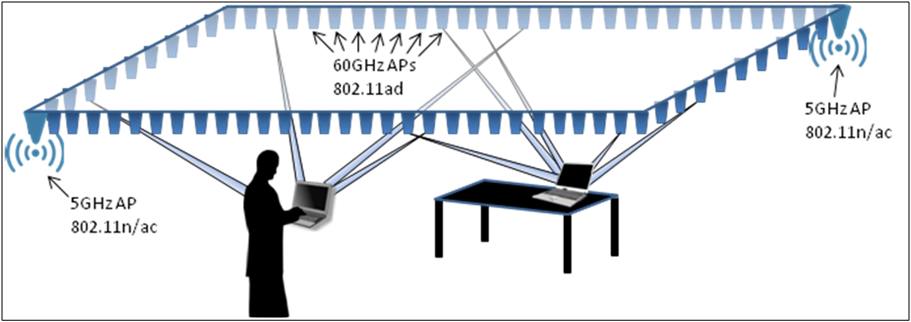
Author: Joerg Widmer, Research Professor & Research Strategy Manager, IMDEA Networks Institute
 The ubiquity and flexibility of wireless access to the Internet played a very significant role in the tremendous growth in mobile devices such as smartphones, tablet PCs, and laptops over the past years. Their tight integration into everyday life is having a substantial impact on society. As a consequence, a larger and larger fraction of Internet traffic is delivered wirelessly. How to deal with this growth is one of the most important challenges for future wireless networks.
The ubiquity and flexibility of wireless access to the Internet played a very significant role in the tremendous growth in mobile devices such as smartphones, tablet PCs, and laptops over the past years. Their tight integration into everyday life is having a substantial impact on society. As a consequence, a larger and larger fraction of Internet traffic is delivered wirelessly. How to deal with this growth is one of the most important challenges for future wireless networks.
In contrast to wired networks where network capacity can be increased simply by installing additional fiber optic lines, increasing the throughput of wireless systems is much more difficult. Wireless links now operate close to their theoretical physical limit and further major efficiency gains are unlikely. As a consequence, the most promising option to substantially increase capacity is to increase the communication bandwidth, since the data rate that can be achieved is directly proportional to bandwidth. While some efforts target the reallocation of lower frequency radio spectrum currently used for purposes other than data communication, sufficient bandwidth to sustain the exponential growth in mobile data traffic is only available in the very high frequency part of the wireless spectrum. At the same time, efficient spatial reuse is extremely important and it is estimated that it alone has increased wireless capacity by a factor of 1600 over the last 50 years. In the past, this has mainly been achieved by reducing the cell size of mobile networks, i.e., the area serviced by a single mobile base station. Mobile networks also increasingly use base stations of different cell size, (overlapping) macro-, micro-, and femto-cells, to improve network efficiency and spatial reuse.
The drive to higher frequencies is evident, for example, in the evolution of the standard IEEE 802.11 (which provides the basis for products using Wi-Fi). Up to now, the widely used IEEE 802.11 standards (namely IEEE 802.11b/g/n) use both the unlicensed 2.4GHz and 5GHz bands. The upcoming IEEE 802.11ac standard, however, only works in the 5GHz band as the available bandwidth at 2.4GHz is insufficient to achieve the intended data rates. While both of these frequency bands have desirable radio propagation properties, they simply do not provide enough bandwidth to fulfill future capacity demands, even when taking into account that regulators may make available additional spectrum for Wi-Fi use in the near future. The most recent IEEE 802.11ad standard takes a major step forward and targets the unlicensed spectrum from 57 to 64GHz known as the 60GHz band. With 7GHz it provides over 80 times the bandwidth compared to the lower frequency bands used for 802.11 and promises data rates of close to 7GBit/s. Recent advances in the design of CMOS* (a widely used technology for constructing integrated circuits) allow building inexpensive 60GHz radio hardware and hence there is significant commercial interest in bringing 60GHz devices to the market in the coming years.
Despite these desirable properties, this part of the spectrum suffers from high attenuation and signal absorption, restricting communication primarily to relatively short line-of-sight connections. (Line-of-sight is the propagation characteristic of high-frequency radio, where generally any obstruction between the transmitting antenna and the receiving antenna will block the signal). As a consequence, suggested use cases for IEEE 802.11ad commonly involve high gain directional antennas to compensate for this loss. Such directional antennas work particularly well for static point-to-point scenarios such as cable replacement, providing high definition video streaming between a Blu-Ray player and a TV screen or high speed file transfer for data synchronization of a mobile device. Fall back to other technologies (for example in case a line-of-sight path becomes unavailable) is explicitly considered through the fast session transfer functionality. It enables seamless session transfer from IEEE 802.11ad to legacy IEEE 802.11 operating at lower frequencies and supports deployments where IEEE 802.11ad provides small islands of high speed communication whereas general coverage is provided through lower frequency technologies.
The much higher bandwidths (and thus higher carrier frequencies) and efficient spatial reuse needed to cope with the exponential increase in future wireless data require a radical rethinking of wireless networking. Further reductions in cell size and similar measures that were used to improve capacity in the past are by far not enough to provide the necessary gains. In analogy to the evolution of wired Ethernet from a shared medium to a fully switched network, we believe that wireless networking has to evolve from using the wireless channel as a shared medium to providing dedicated highly optimized channels to wireless devices.
The key element for the scalability of future wireless networks is thus to provide a large number of highly directional individual channels for communication between access points (APs) and end devices. This has two major benefits. First, highly directional antennas provide the antenna gains required for efficient high speed communication in the very high frequency domains that experience a high degree of attenuation. At such frequencies, communication primarily requires channels that are line-of-sight. Second, due to the directionality, such a system imposes very low or no interference on other end devices and thus allows for spatial reuse that is orders of magnitude higher than that of current technology. All these considerations apply even more to future terahertz communication systems operating at even higher frequencies above 300GHz.
The main challenge with such an approach is the dynamic radio environment. In conjunction with mobile end devices and human movement, even an indoor environment is extremely dynamic and channels may appear and disappear over very short time intervals. At the same time, since such channels experience very little interference, resources (time, frequency, signal processing, etc.) that would otherwise be used to handle interference can now be used to further increase achievable data rates between sender and receiver. To provide sufficiently many line-of-sight channels, access points may have to be deployed ubiquitously and may vastly outnumber mobile devices.
The focus of the research led by IMDEA Networks in this area is the design of a wireless network architecture that maintains a number of directional line-of-sight channels between several access points (APs) and end devices as shown in Figure 1. Data is transmitted simultaneously via all of these channels. An end device uses multiple antennas to receive and decode several such data streams, and the higher the number of received streams, the higher the data rate achieved at the receiver. The main complexity of the design lies in the selection of APs as well as the beamforming directions of their antennas, given the large number of end devices that future wireless networks will have to support. As a backup, when no directional channels can be established and for the timely transmission of control information, the system also employs a conventional wireless local area network that does not require line-of-sight channels and the use of directional antennas.

Figure 1: SEARCHLIGHT beamforming
Spectrum for the Masses: Networking in the Millimeter Wave Band
Compared to state-of-the-art wireless systems, we expect that such an architecture
- Scales to very high bandwidths and allow for unprecedented levels of spatial reuse, while maintaining very low levels of interference
- Scales to much larger numbers of APs than current deployments through the centralization of intelligence and processing at the wireless network controller and encoder/decoder module, thus keeping AP cost and complexity low
- Despite the vast increase in number of APs can operate at a similar or lower level of power consumption compared to current systems due to efficient AP sleep mechanisms
We believe that this project will have substantial scientific impact as a promising way forward for the design of wireless networks one generation after the next. It addresses the big challenges in wireless communication: bandwidth, interference, spatial reuse, and processing complexity to deliver a more scalable, energy-efficient, and cost effective wireless network design. This research is performed as part of the SEARCHLIGHT project, an ERC Consolidator Grant of 1.7 million Euro awarded by the European Research Council (ERC). ERC grants are the most renowned individual grants for researchers in Europe and a major indicator of excellence in scientific research. The project has a duration of 5 years, from April 2014 to March 2019.
*Complementary metal–oxide–semiconductor

